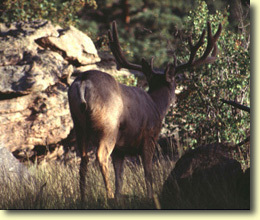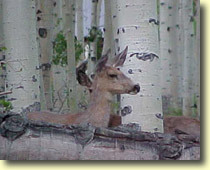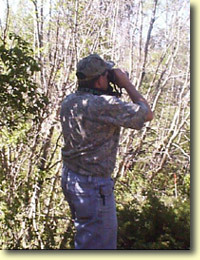"Where have all the mule deer gone?"
"Some thoughts on the problems facing mule deer today"
 |
So what really has happened to our mule deer populations? Where have all the mule deer gone? If you asked this question to 20 different wildlife biologists, you would most likely get a different answer from each of them. It amazes me, as a biologist, the response I get from this question; everyone has his or her own opinion and it's hard to get a real good answer. The fact is mule deer and mule deer populations are complex and static. To narrow their decline down to one specific problem would be ludicrous. However, in talking with my peers I've come up with several real problems facing our mule deer right now. While I'm sure there are plenty more out there, I would like to share a few of them with you.
 |
When most of us think of habitat loss, we think of loss due to development. However, loss of habitat is more than just development. There are many other habitat losses that need to be considered; overgrazing, fire frequency, fire suppression, improper management, or simply a natural successional change in habitat are all habitat losses and they can and do contribute to loss in mule deer numbers and create fragmentation within a population. Further, lack of or bad habitat can increase predation, starvation, disease, stress levels, and general fitness of the animals by concentrating them in certain areas. The truth is, we have lost some habitat that we will never get back. We've got to work with our local biologists to identify, improve, and protect what we have left. Only then will our mule deer have a fighting chance to return. I've listened and talked with many people who gripe and complain about declining mule deer numbers, but very few of them get involved. We can't just sit back and complain about the loss of habitat any longer and expect things to get better. When was the last time you sat down with your local biologist and asked him or her what you could do to help? We can't expect the habitat to change overnight; we must get involved and help where and when we can.
 |
The natural history of mule deer dictates that the does (females) will select to breed with the most dominant mature male in the population, this ensures strong, "fit" offspring and leads to a healthy population. This dominant buck, should be a 5-7 year old buck. Unfortunately, there aren't too many places in the west where this is happening. With all the small groups of does and fawns we see during the rut, it is almost impossible for one or two mature bucks to breed 30 does, let alone 100. There might be a few places where the big boys are doing the majority of the breeding, but it certainly is not the norm. What is more typical today, is having yearling and second year bucks doing the majority of the breeding. So why is this so bad? The genes are still there; it really shouldn't matter right? Wrong! From a genetic point of view, it doesn't really matter. However, a doe usually won't breed with an immature buck during her first estrus (usually November) cycle. However, if conditions are right, (if she is 'fit') she will come into estrus again the next month (usually December) and breed with a younger/juvenile buck, if a mature buck is still absent. From a biological stand point this is probably the worst thing that can happen to mule deer. This leads to fawns being born in July/August instead of May/June, leading to smaller fawns in the winter, leading to higher fawn mortality during the winter months and being less 'fit' the following spring. Ask yourself when the last time you saw a fawn with spots in late August, this shouldn't be. This can also effect the "fitness" of the fawn, leaving it more susceptible to disease, starvation, and predators. The ramifications of this one problem are almost endless. We just can't continue to manage for quantity of animals, we've got to start managing for quality. This means we can't have our yearling bucks doing most of the breeding, we must manage for an even-age distribution of bucks in the population. Its important we realize this, we, as hunters, just can't continue to kill anything that has antlers and expect our mule deer population to increase (I'm not saying we all need to be trophy hunters either). I find it funny, as well as sad, to listen to the younger generation say, "we saw some real big two points!" How sad is that? I'll bet many of our young hunters have never even seen a 5.5 year old buck. I agree there needs to be a certain number of yearling bucks taken from the population, but lets allow a few of the bambies to grow up and get big, so they can breed the does. If we don't, and we continue down this path, there won't be any mule deer for our children to see, except in zoo!
 |
 |
Lastly, a big problem facing mule deer, is the lack of money and bad politics. Too often in may states mule deer management decisions are being made on the number of licenses sold, instead of on sound biological principals. We as hunters should be fighting tooth and nail with our local legislatures and public processes to give more general funding to our state wildlife agencies. We should demand accountability on how that money is spent, and demand our state agencies to follow the management plans they have developed and not sell out because they are afraid of losing revenue. We shouldn't complain about the price of licenses, we should complain that the state isn't getting more of our tax dollars to help run our wildlife resources. We shouldn't sit idly by and gripe and moan about present problems. We need to organize ourselves as hunters and those concerned about our natural resources. We should get involved and help support those non-profit groups located in your area who contribute time and money to mule deer management. Only by giving of our time, helping our local game management people, and participating in the public process, can we make a difference in the future of mule deer.
The truth is, mule deer are in trouble throughout the west. Some professionals would argue that the declining populations of mule deer is just part of natural selection and evolution, "the mule deer are on there way out", it's just a matter of time. Myself on the other hand, I would like to believe they still have a fighting chance. As a whole, I'm concerned, as should each of you be. If we don't start doing something soon, it may be too late for mule deer. I've read enough to know and understand a little about fragmentation, biology, and natural history, to know that having year after year of declining populations, that it will only take another bad winter or two until someday, they maybe gone. Hopefully through education, proper management, ethics, time, money, and a little luck, we can bring the mule deer back to a number that our habitat can support. Wouldn't it be nice to see them how they once were three decades ago?
About the author; Todd A. Black is a wildlife biologist and environmental consultant. Currently he works for Utah Power and Utah State University. He has been working the past few years in starting his own business with a couple of college buddies "COMPLETE WILDLIFE MANAGEMENT SERVICE", where he works with private landowners in helping them realize the benefits of wildlife. He enjoys hunting, photography, birding, and spending time with his family. Originally from Blanding, Todd currently lives in Hyrum Utah.
Click-a-Pic ... Details & Bigger Photos
Click-a-Pic ... Details & Bigger Photos
Videos | Hunts & Tags | About Mule Deer | About Elk
Classified Ads | Photo Tours | About this Site | Advertising |
Older Content | Email Us | Privacy Policy
